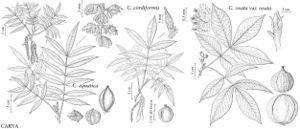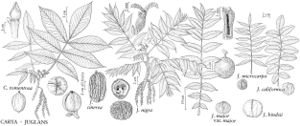Juglandaceae
Trees, rarely shrubs, deciduous, with gray or brownish bark. Terminal buds larger than lateral buds. Leaves alternate [or opposite], aromatic, usually odd, rarely even, pinnately compound; stipules absent; petiole present. Leaflets 3-23, margins serrate or entire. Inflorescences: staminate catkins solitary or fasciculate, pendulous, elongate, on reduced shoots arising on branches of previous year or at base of current-years growth; pistillate catkins solitary or few-flowered spikes [or many-flowered racemes]. Flowers unisexual, staminate and pistillate on same plants; bract 1, bracteoles (0-) 2. Staminate flowers: calyx 2-6-lobed or absent; corolla absent; stamens 3-50; filaments very short or absent; anthers usually pubescent. Pistillate flowers: calyx 4-lobed or absent; corolla absent; ovary 1, inferior, usually 2-carpellate, 1-locular distally; ovule 1; stigmas 2, fleshy or plumose. Fruits large nuts [or samaras], nuts enclosed in dehiscent or indehiscent, fibrous-fleshy or hard involucres (husks), thus ± drupelike. Seeds 1; endosperm absent; cotyledons fleshy and oily, variously lobed.
Distribution
Western Hemisphere and Eurasia
Discussion
Genera 7, species 59 (2 genera, 17 species in the flora).
The fruit in Juglandaceae superficially resembles a drupe, with a hard "stone" surrounded by a soft, often fleshy husk. The husk, however, is not part of the fruit wall (it develops from the involucre and calyx), and the fruit is actually a nut (T. S. Elias 1972; W. E. Manning 1978).
The morphology and classification of the family were discussed by W. E. Manning (1978). The female inflorescences and fruits show considerable variation in Latin American and Eurasian taxa.
Selected References
None.
Illustrations
Key
| 1 | Branchlets with solid and homogeneous pith; distal leaflets largest; staminate catkins in sessile or pendunculate fascicles, stamens 3-10(-15) per flower; fruits with husks completely or partially dehiscent, nuts smooth, verrucose, or rugulose. | Carya |
| 1 | Branchlets with chambered pith; leaflets uniform in size or median leaflets largest; staminate catkins sessile, solitary, stamens 7-50 per flower; fruits with husks indehiscent, nuts grooved, ridged, furrowed, or smooth. | Juglans |

